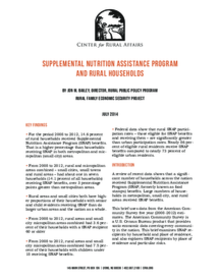Small Towns
A review of recent data shows that a significant number of households across the nation received Supplemental Nutrition Assistance Program (SNAP, formerly known as food stamps) benefits. Large numbers of households in metropolitan, small city, and rural areas received SNAP benefits.
This brief uses data from the American Community Survey five year (2008-2012) estimates. The American Community Survey is a U.S. Census Bureau product that provides socio-economic data covering every community in the nation. This brief examines SNAP recipients by household and place of residence, and also explores SNAP recipients by place of residence and particular risks.
Key findings
- For the period 2008 to 2012, 14.6 percent of rural households received Supplemental Nutrition Assistance Program (SNAP) benefits. That is a higher percentage than households receiving SNAP in both metropolitan and micropolitan (small city) areas.
- From 2008 to 2012, rural and micropolitan areas combined – small cities, small towns and rural areas – had about one in seven households (14.1 percent of all households) receiving SNAP benefits, over 3 percentage points greater than metropolitan areas.
- Rural areas and small cities both have higher proportions of their households with senior and child residents receiving SNAP than do larger urban areas and the nation as a whole.
- From 2008 to 2012, rural areas and small city micropolitan areas combined had 3.6 percent of their households with a SNAP recipient 60 or older.
- From 2008 to 2012, rural areas and small city micropolitan areas combined had 7.5 percent of their households with children under 18 receiving SNAP benefits.
- Federal data show that rural SNAP participation rates – those eligible for SNAP benefits and receiving them – are significantly greater than urban participation rates. Nearly 86 percent of eligible rural residents receive SNAP benefits compared to nearly 73 percent of eligible urban residents.


